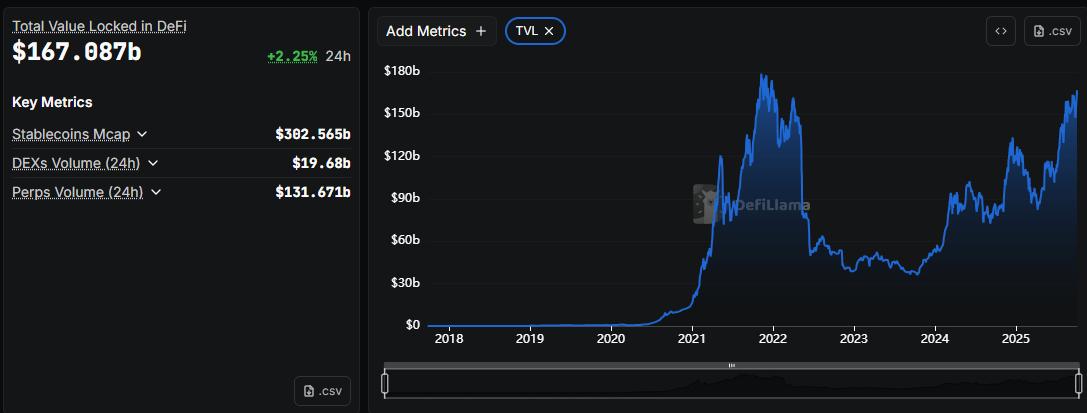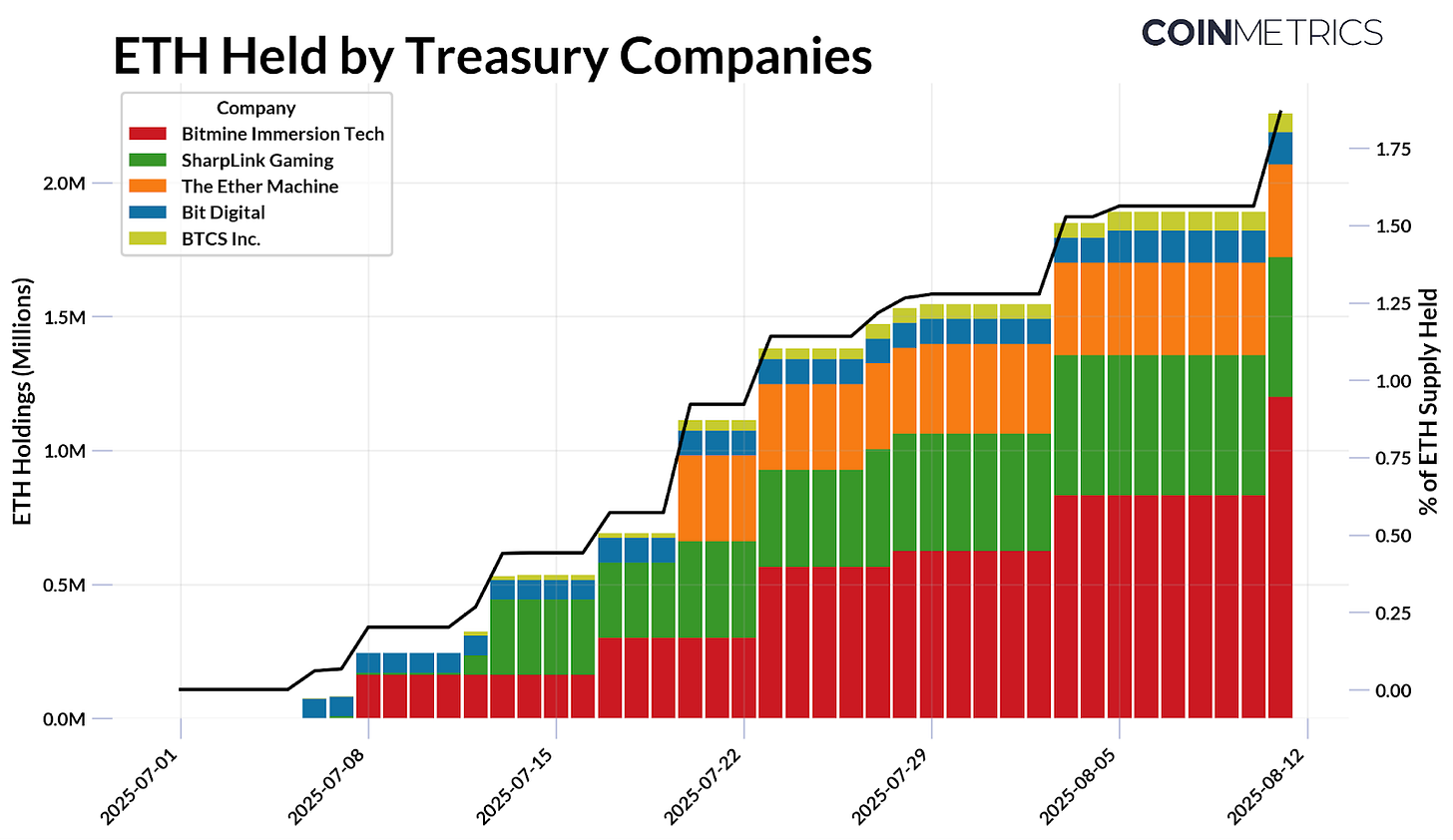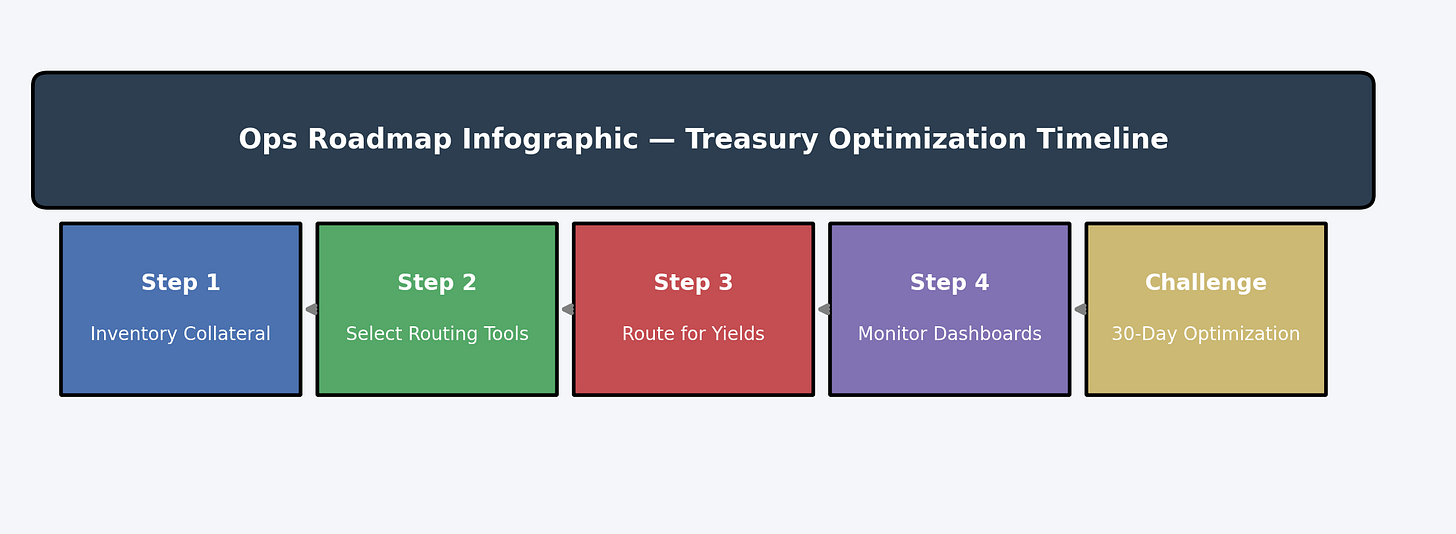Crypto Treasury Ops Deep Dive: Multi-Venue Collateral Routing That Cuts Fees 20-40 bps
Crypto treasuries hit $150B in 2025, yet most still overpay on fees. The ones in the know route across venues, cut 30 bps per move, and compound those savings into real alpha using pro-level tactics.
TL; DR
Most DAOs and funds lose 20-40 basis points on every transfer by relying on single-venue moves, while smarter competitors use multi-venue routing to save millions.
In 2025, treasury management is all about efficiency, with over $150B in assets flowing across chains and Layer-2s. Routing dynamically trims hidden costs and boosts yields by 2-5%, turning treasury ops into a profit driver.
Tools like Socket, LI.FI, and Aave help automate transfers and optimize collateral across venues. Case studies show DAOs saving $500K a year and funds cutting millions in fee drag through optimized routing.
Risks like bridge exploits and oracle failures exist but are managed with insurance and buffers.
By 2026, with AI-driven routing and institutional adoption, multi-venue efficiency will be the standard for crypto treasuries.
The Crypto Treasury Revolution
What would you do if every collateral move you made was costing 20-40 basis points more than it should? Most DAOs and funds don’t even realize it’s happening. They move USDC or ETH across a single venue, eat the fees, and call it a day. Meanwhile, their savvier competitors are quietly saving millions through smarter routing.
In 2025, crypto treasury management should be about efficiency. With more than $150 billion in DeFi treasuries under management, the real edge comes from how capital is moved, and that’s where multi-venue collateral routing flips the script.
Figure 1: Top 10 Crypto Projects with the Biggest Treasuries (Source: @CryptoDiffer/X, September 2025)
Instead of letting assets sit siloed on one chain or exchange, routing lets treasurers shift collateral dynamically across venues, whether that’s jumping from Ethereum to a Layer-2 lending pool, or rerouting through the cheapest bridge before deploying into a DEX. Done right, this trims 20-40 bps in hidden costs and often boosts yields by 2-5%.
Treasury ops have gone from niche back-office work to being the engine of competitive advantage. Tools like Aave have made the basics accessible to newcomers, but top funds now treat routing as an art form. My first time running a multi-hop transfer felt like a cheat code, watching fees collapse and returns climb in real time.
This guide to multi-venue routing is your playbook. You will see how it works, what tools make it possible, and how leading funds are already saving six to seven figures per year by putting it into practice.
In the next section, we will break down what actually happens when you route collateral across venues, and why the wrong bridge can erase every gain.
Treasury Ops Surge in 2025
If 2022 was about survival, 2025 is about optimization. The bear market forced DAOs and funds to rethink every basis point, and now treasury desks are emerging as the strategic core of crypto organizations. Assets under active treasury management have grown from $50B in 2022 to over $150B in 2025, a threefold increase that tracks directly with the rise of smarter routing.
Figure 2: DeFi Total Value Locked Growth (Source: DeFiLlama)
One standout case comes from a DAO highlighted in a Delphi Digital report: after years of fee drag, they turned their treasury around post-bear market by adopting multi-venue routing, cutting costs on every move and freeing up capital for reinvestment. That single shift helped stabilize their runway and boosted community confidence. Stories like this aren’t rare. They’re becoming the norm among funds that treat treasury ops as a profit center, not a cost sink.
Automation and collateral efficiency are driving these. Instead of relying on manual transfers or siloed custody, treasuries now use routing engines that automate flows between lending markets, DEXs, and Layer-2s. It’s not just about saving 20-40 bps per move but scaling that across billions in flows. This is where the idea of “crypto treasury explained 2025” really lands because efficiency is table stakes for survival and growth.
Demystifying Treasury Ops: Collateral, Routing, and Fee Savers
So, what’s treasury ops really all about? At its core, it’s collateral, routing, and fee control. If you’re new, think of collateral as your fuel, stable coins like USDC or volatile assets like ETH locked to earn yield, back loans, or secure liquidity. If you’re a pro, you know the edge comes from where and how you route that collateral. That’s where AI-optimized strategies and smarter infrastructure are shaving costs that used to feel unavoidable.
Routing is the circulatory system of modern treasuries. Instead of leaving assets parked in a single chain, funds move them dynamically through bridges and venues. For example, Across Protocol lets you route USDC from Ethereum to Arbitrum in seconds, often at half the cost of legacy bridges. Fees that once ran 10–50 bps per transfer on congested L1s now collapse to a handful of bps on Layer-2s like Arbitrum, where settlement is almost instant. That’s the efficiency play funds can’t afford to ignore.
Onboarding is simpler than most think:
Assess your holdings: Map out stable coins, ETH, and other positions across chains.
Pick your routers: Tools like Socket and LI.FI have emerged as go-to routing engines for multi-chain ops.
Simulate your routes: Before you move $10M in collateral, test-run paths to compare fees, slippage, and settlement times.
Ninety percent of treasuries are now multi-chain, with total value locked (TVL) in cross-chain protocols nearing $200B in 2025 (Messari). DAOs lean on audit trails for community accountability, while funds focus on scale, routing large transfers with minimal gas overhead. Both win by cutting costs and freeing capital for more productive uses.
Pro tip: My first time simulating a route in Socket felt like a revelation. Watching a 50-bps cost drop to 12 bps proved that optimization isn’t theory. It’s real money.
The Treasury Boom: Why Multi-Venue Routing Rules 2025–2026
Treasuries in crypto are exploding. In 2022, the space barely scraped $50B in managed assets. By 2025, we’re past $150B, and momentum points to even more. Why? Because regulation is finally catching up. The EU’s MiCA rules and U.S. guidance have opened the door for institutions, and with that scale comes the demand for smarter, cheaper collateral flows. Every basis point now matters.
The new playbook centers on multi-venue routing. In a world where fees on a single $10M treasury move can swing by 40 bps or more, the winners are those who route collateral across Layer-2s and liquidity venues to capture the spread. Add in the rise of L2 scalability (Arbitrum, Base, Optimism) and oracle accuracy from Chainlink, and we are seeing efficiency gains in the 60-80% range compared to just a few years ago.
Figure 3: Corporate Treasury ETH Positions. Source: CoinMetrics Substack
Routing isn’t just cost control. Imagine this scenario: ETH yields on Ethereum sit at 4%. But on Base, incentives push returns to 12%. If your routing stack can shift instantly, that’s a 3x jump in yield without new risk exposure. Those who hesitate leave money on the table; those who move win.
The best way to optimize is to always start with liquidity. High-liquidity venues mean tighter spreads, less slippage, and bigger savings. Then, layer in routing logic that adapts in real time. Treasuries that master this rhythm compound efficiency into higher APY.
This is the rise of crypto treasury ops 2025. Routing has gone from an edge to a requirement. The question isn’t whether you will adopt it, but how fast you can make it part of your playbook.
Unpacking Drivers: How Routing Slashes Fees and Boosts Yields
The efficiency gains from multi-venue routing in 2025 are no longer anecdotal but quantifiable, repeatable, and backed by metrics across protocols and funds. Routing has emerged as one of the core profit drivers in crypto treasury management, directly impacting both fee reduction and yield optimization.
Fee Compression at Scale
On average, funds using routing engines in 2025 report 25% lower transfer costs compared to direct swaps or legacy bridges. This isn’t theoretical. A Kaiko case study showed a hedge fund cutting 35 basis points per transfer simply by routing through optimized paths. At the aggregate level, integrations across 11 leading protocols now generate $5 million in daily savings globally, capital that can be reinvested or deployed for yield.
Yields Enhanced by Routing
Routing also drives performance on the revenue side. According to Messari, funds like Yearn Finance are reporting net APYs near 8%, even in a compressed yield environment, largely due to their ability to minimize fee drag and capture micro-arbitrage across venues. The compounding effect is significant: cutting 20-40 bps in transfer costs and redeploying at scale translates into several percentage points of net APY gain annually.
Case-Level Evidence
A DAO with $1B AUM adopting cross-chain routing saved approximately $500K per year, redirecting that margin into incentive programs.
Hedge funds managing smaller portfolios still benefit proportionally. One $100M fund reported that routing cuts of 30 bps per transaction improved their quarterly returns enough to offset full-time ops costs.
Funds leveraging 11+ integrations achieve top efficiency per asset, as routes can be tailored to the liquidity, volatility, and gas profiles of specific tokens.
Insight: Routing is a strategic lever for crypto treasury profit drivers. Funds that ignore it will not only overpay on fees but also underperform in yield relative to peers.
Competitive Edge: Why Multi-Venue Beats Single-Chain Ops
Multi-venue routing is outcompeting single-chain treasury operations across cost, yield, and liquidity access. According to Chainalysis, as of mid-2025, nearly 35% of all DeFi fee savings can be traced directly to optimized routing. That means treasuries that route is capturing basis points others simply bleed away.
Single-Chain Limits vs. Multi-Venue Scale
Aave remains a foundational platform for collateralized lending, but its single-chain concentration exposes treasuries to limited liquidity and higher marginal costs during network congestion. In comparison, Yearn’s auto-routing strategies dynamically allocate across multiple venues and chains. The result: Yearn has captured more than 75% of share-of-liquidity among yield aggregators, primarily because routing unlocks efficiency at scale (Messari).
Why Multi-Venue Wins
Routing converts what used to be passive treasury management into an active optimization layer. Instead of accepting fixed returns, treasuries dynamically capture tighter spreads, lower slippage, and cross-chain yield incentives. Traders now routinely describe multi-venue ops as a “yield masterclass,” because the delta is visible in performance metrics: 20–40 bps per transaction saved, plus 2–5% APY enhancement annually.
Scenario Analysis
Consider a treasury moving $100M in stablecoins over a quarter. A single-chain flow could lose 35–50 bps in accumulated fees, equating to $350K–$500K in cost drag. A multi-venue setup, by contrast, routes those flows through high-liquidity bridges and L2s, recapturing most of that margin. Over a year, that differential is equivalent to an entire operational budget for many DAOs.
The bottom line is that in crypto treasury management 2025, routing is no longer optional. Funds and DAOs that fail to adopt it operate at a structural disadvantage, effectively paying a hidden tax on every move.
Risks and 2026 Outlook
Every efficiency gain comes with risk. In treasury ops, the main vulnerabilities remain bridge exploits and oracle failures. Cross-chain bridges have historically been the weakest link, with more than $2.8B lost to hacks between 2021–2023 (Chainalysis). Oracles, while increasingly accurate, still present tail risks when price feeds lag or are manipulated in thin markets. These are not theoretical—they have been the trigger for multi-million-dollar liquidations.
Risk Mitigation in Practice
Leading treasuries counter these exposures with insured routes and conservative buffers. Using services like Nexus Mutual or protocol-native insurance wrappers, DAOs now cover high-value transfers, effectively capping downside. Funds also maintain 150% collateral buffers in lending venues, ensuring that even under volatile conditions, positions remain solvent if an oracle slip occurs. These controls convert catastrophic risk into manageable operational overhead.
2026 Outlook: Growth and Standardization
Despite risks, the growth trajectory remains strong. DeFi treasury assets are projected to exceed $250B by 2026, driven by institutional adoption under clearer regulatory regimes (Messari). The most notable shift will be AI-driven routing engines, which are already piloted by funds to simulate thousands of paths in real time. Early data shows 50 bps efficiency gains on large-volume transfers when AI optimizes for fee, slippage, and liquidity simultaneously. By 2026, this is likely to become an industry standard.
Relative Benchmarking
Even in worst-case scenarios, bridge downtime or isolated hacks, multi-venue routing remains structurally superior to CeFi wires. Average bank wires still cost ~100 bps in FX and service fees for global transfers, compared to sub-25 bps on insured, audited routes. In other words, the downside case for DeFi treasuries is still nearly 4x more efficient than the traditional alternatives.
Bulls on yields or bears on bridges?
In the final wrap, we’ll outline a step-by-step playbook for treasuries to adopt multi-venue routing today, and share the tools worth piloting before 2026’s AI-driven wave hits.
Your Action Plan: Route and Optimize Treasury Ops
Treasuries that adopt structured routing frameworks are already outperforming their peers in efficiency and yield capture. Below is a step-by-step playbook designed for DAOs, funds, and institutions looking to bring their crypto treasury management 2025 up to professional standards.
Step 1: Inventory Collateral
Begin by mapping all current holdings across chains and venues. Most treasuries are overweight in stablecoins (USDC, USDT, DAI) and ETH, but exposures often fragment across L1s and L2s. Without a clear ledger, routing inefficiencies compound. Benchmark against sector averages: over 70% of treasuries are now multi-chain (Messari), so siloed assets represent structural underperformance.
Step 2: Select Routing Tools
Leading protocols such as DeFi Saver, Socket, and LI.FI offer automated routing with risk controls. Tool selection should be based on three measurable factors: liquidity coverage (number of venues integrated), fee efficiency (bps saved per route), and audit status. In 2025, audited routers with multi-protocol coverage typically deliver 25–35% lower fees versus single-path bridges.
Step 3: Route for Yields
Execution is about dynamic allocation. Collateral should be routed toward the highest net-yielding venues, factoring in both APY spreads and fee drag. For example, ETH routed into Base during incentive spikes can generate 2–3x relative returns compared to static Ethereum staking. Tracking opportunity cost at the bps level ensures that routes add incremental alpha instead of just reducing drag.
Step 4: Monitor Dashboards
Routing requires feedback loops. Treasuries increasingly rely on dashboards like Dune Analytics or in-house monitors to track fee savings, yield capture, and TVL allocations. A rule of thumb: once aggregate routed TVL across protocols hits $100B, liquidity is deep enough that execution slippage is negligible. In early 2025, this threshold was already crossed, signaling maturity in multi-venue markets.
Resources for Scaling:
Join Treasury-focused Discords (e.g., DAO Treasury working groups, DeFi Saver forums).
Test flows on Goerli or other testnets before deploying size.
Review audit trails for governance transparency—critical for DAOs reporting to tokenholders.
30-Day Optimization Challenge:
Day 1: Conduct a treasury audit; inventory all collateral and current routing paths.
Day 15: Pilot multi-venue routes with <$1M test sizes.
Day 30: Tally basis points saved and yield increases. Funds running this challenge consistently report 0.5–1.0% annualized efficiency gains after the first month.
Share your biggest routing hack in the comments. Did you cut 30 bps on a move? Did your DAO unlock $500K in savings this year?
Figure 4: Ops Roadmap Infographics
To close, we will recap the strategic shift, which is why routing is no longer optional, how AI will reshape treasury ops by 2026, and why treasuries that move first will lock in compounding advantages.
Conclusion: Master Your Crypto Treasury
The evidence is conclusive that multi-venue collateral routing has become the defining edge in crypto treasury management 2025. From reducing 20-40 bps per transfer to unlocking incremental 2-5% APY boosts, routing is no longer a back-office upgrade but a core strategic weapon. DAOs saving $500K annually and funds compressing millions in fee drag illustrate the magnitude of this shift.
Either treasuries lead the efficiency wave by adopting routing frameworks, or they continue to pay hidden taxes on every move. As Chainalysis and Messari data show, the institutions that move first are locking in compounding advantages, lower costs, stronger yields, and a credibility premium in governance reporting. For laggards, the opportunity cost grows by the quarter.
Looking forward, the playbook only deepens. With AI-driven routing simulations already piloted by funds for 50 bps additional efficiency gains, the next cycle will reward treasuries that standardize automation and multi-protocol integrations. By 2026, projections point to $250B-300B in treasury assets, and routing will be table stakes, not an edge.
Subscribe for treasury ops guides, yield strategy breakdowns, and the latest DeFi tools. Stay ahead with actionable updates, because the next chapter is AI-powered treasury tactics, and those who prepare now will set the benchmark for efficiency.
Disclaimer: This article is for informational purposes only. It does not constitute financial advice, a recommendation to buy, sell, or hold any asset, or an endorsement of any specific strategy. The crypto market is highly volatile and risky. Always do your own research (DYOR) and never invest more than you can afford to lose.








